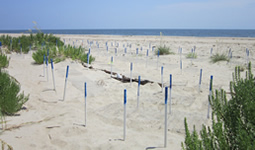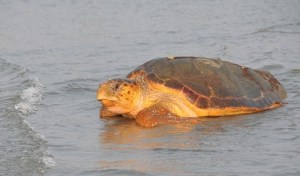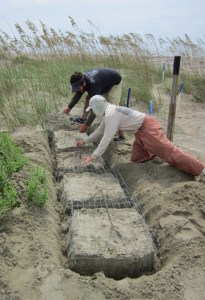Loggerhead Sea Turtle Conservation at Cape Romain: 35 years of work paying off!
Our national wildlife refuges are dedicated to preserving the diversity of species that makes our world and our lives rich and interesting. With your generosity we are proudly supporting their efforts. For ten years the Association has been supporting loggerhead sea turtle recovery efforts on Cape Romain National Wildlife Refuge by funding field technician positions during the nesting season, supporting predator control efforts and providing needed supplies and materials.
The work at Cape Romain is so important because while the refuge has only about 10% of the suitable nesting beaches in South Carolina it is home to about 35% of the nests laid in the state; making the refuge the most important breeding ground for loggerheads north of Florida.
During the 50 plus days of incubation turtle eggs are vulnerable to predators (like raccoons) and, because of beach erosion, to being washed over by high tides. So sea turtle conservation must begin with protecting nests. On Cape Romain this effort is nothing short of heroic. From late April to late August over 80 volunteers donate over 6,000 hours to the refuge’s nest protection and monitoring efforts. They are led by two full time field technicians and Cape Romain’s biologist. Seven days a week the work begins at dawn before most of us have even hit the snooze button for the first time. Crews work tirelessly to ensure every nest on the refuge has the best possible chance of producing hatchlings.
The nests that are being protected today are producing the turtles that will return as breeding adults in 30 to 35 years. Because turtles mature so slowly, assessing population trends is a long term commitment. Loggerhead sea turtles were initially protected in 1978 and the efforts since that time seem to be paying off. Nesting numbers have steadily increased at Cape Romain over the last several years, peaking at a record 1,906 nests in 2013. Florida, Georgia and North Carolina are also reported record high numbers of nests.
Today’s breeding adults may well be some of the first hatchlings to have benefited from population recovery efforts that began 35 years ago. Refuge manager Sarah Dawsey is quick to remind that many factors are at play and that although it seems likely that nest protection efforts are paying off only time will tell. She also adds that public education and protecting turtles while they are at sea are also critical components of the conservation effort.
Other important work is also taking place on Cape Romain’s beaches. Genetics research being conducted on the refuge in conjunction with the University of Georgia will allow researchers to track the nesting patterns of individual females and their offspring. Researchers will be able to identify a given female’s offspring and determine how close to her actual hatching site a daughter returns to lay her eggs. This is all accomplished by analyzing the DNA signature in the shell of a turtle’s egg, and will give valuable information as to how many turtles are actually nesting as well as where and when individual turtles are nesting. As sea levels rise and current nesting beaches continue to be lost to erosion, biologists will be faced with new and greater management challenges. The information gathered from this study will be critical in guiding their future efforts and assessing population trends. For more information on this important genetics research and more nesting statistics check out www.seaturtle.org.



